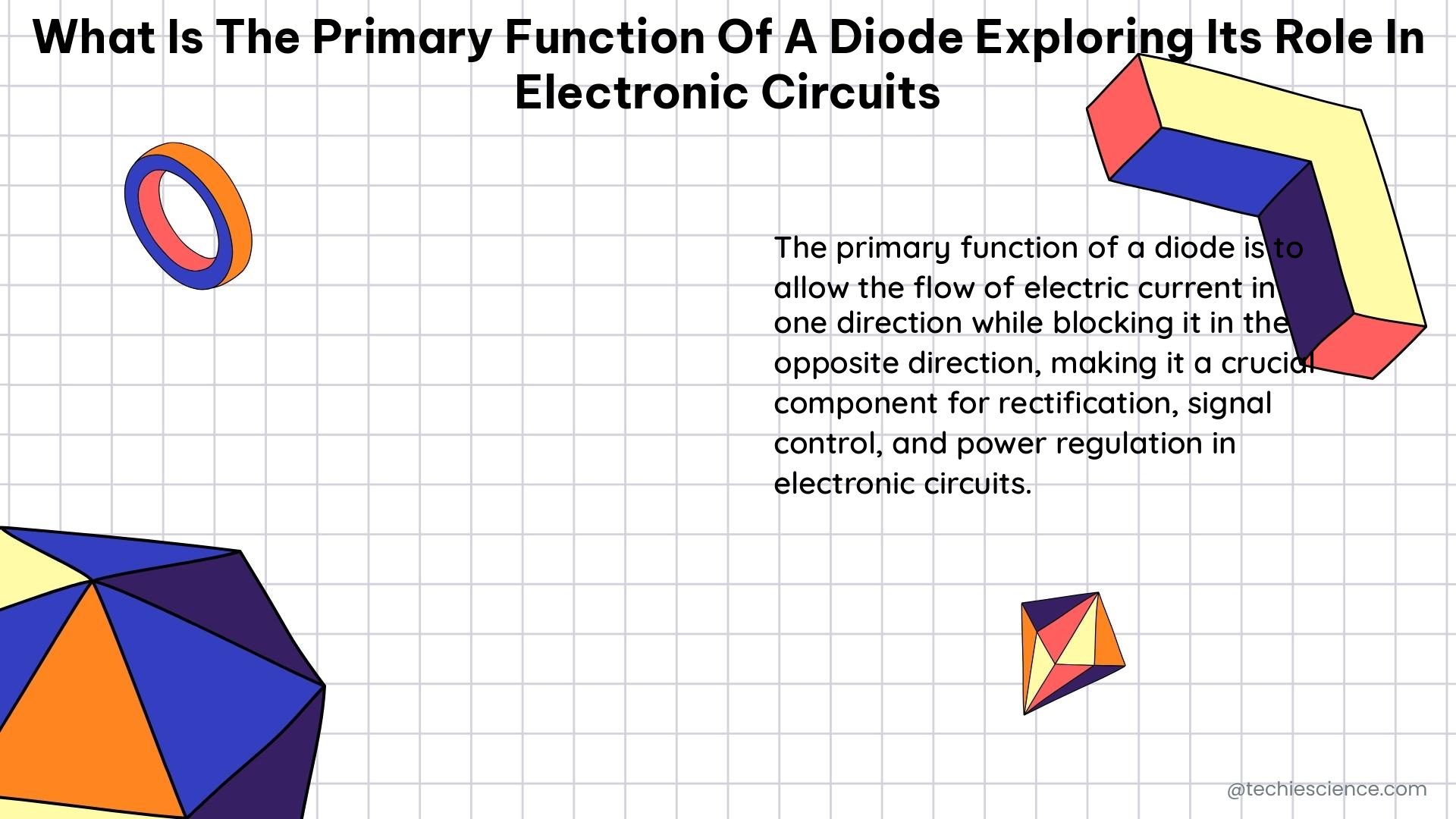The diode is a fundamental electronic component that plays a crucial role in the functioning of various electronic circuits. Its primary function is to allow the flow of electric current in one direction while restricting it in the opposite direction, a phenomenon known as unidirectional current flow. This unique property of the diode is achieved through its intrinsic p-n junction, which creates a barrier that either facilitates or hinders the movement of electrons based on the applied voltage.
Understanding the P-N Junction
The p-n junction is the heart of a diode, formed by the interface between a p-type semiconductor (which has an excess of holes) and an n-type semiconductor (which has an excess of electrons). When these two materials are brought together, a depletion region is formed at the junction, creating a potential barrier that opposes the flow of current in one direction.
When a positive voltage is applied to the p-type material (the anode) and a negative voltage is applied to the n-type material (the cathode), the potential barrier is reduced, allowing electrons to flow freely from the n-type to the p-type material. This is known as the forward-biased condition, and it is the primary mode of operation for a diode.
Conversely, when a negative voltage is applied to the p-type material and a positive voltage is applied to the n-type material, the potential barrier is increased, effectively blocking the flow of electrons. This is known as the reverse-biased condition, and it is the mode in which a diode restricts the flow of current.
Diode Ratings and Characteristics

Diodes are rated according to various parameters, including their type, voltage, and current capacity. These ratings are crucial in determining the appropriate diode for a specific application.
Diode Types
There are several types of diodes, each with its own unique characteristics and applications:
- Silicon Diodes: These are the most common type of diodes, known for their low forward voltage drop (typically 0.5 V to 0.8 V) and high reverse breakdown voltage.
- Germanium Diodes: Germanium diodes have a lower forward voltage drop (typically 0.2 V to 0.3 V) compared to silicon diodes, making them suitable for low-voltage applications.
- Schottky Diodes: Schottky diodes have an even lower forward voltage drop (typically 0.2 V to 0.4 V) and faster switching speeds, making them ideal for high-frequency and power-efficient applications.
- Zener Diodes: Zener diodes are designed to operate in the reverse-biased region, allowing them to maintain a constant voltage drop across their terminals, making them useful for voltage regulation and protection circuits.
- Light-Emitting Diodes (LEDs): LEDs are a special type of diode that emit light when forward-biased, finding widespread use in various lighting and display applications.
Voltage and Current Ratings
Diodes are also rated based on their voltage and current handling capabilities:
- Voltage Rating: The voltage rating of a diode represents the maximum reverse-bias voltage it can withstand before breaking down. This is known as the reverse breakdown voltage.
- Current Rating: The current rating of a diode indicates the maximum forward current it can handle without being damaged. Exceeding this rating can lead to diode failure, either by shorting or by completely blocking the current flow.
Resistance Characteristics
The resistance characteristics of a diode also play a crucial role in its performance:
- Forward-Biased Resistance: When a diode is forward-biased, its resistance should be relatively low, typically ranging from 1000 ohms to 10 ohms, depending on the specific type and rating of the diode.
- Reverse-Biased Resistance: When a diode is reverse-biased, its resistance should be extremely high, often indicated by an “OL” (overload) reading on a digital multimeter.
Applications of Diodes in Electronic Circuits
Diodes have a wide range of applications in electronic circuits, including:
- Power Supply Circuits: Diodes are used in power supply circuits to convert alternating current (AC) to direct current (DC), ensuring a steady and reliable power source for various electronic devices.
- Signal Demodulation: In communication systems, diodes are used for demodulating signals, extracting the original information from a carrier wave.
- Voltage Regulation: Zener diodes are commonly used in voltage regulation circuits, maintaining a constant voltage drop across their terminals, even with fluctuations in the input voltage.
- Circuit Protection: Diodes can be used in protective circuits to shield sensitive components from potential damage due to voltage spikes or surges.
- Rectification: Diodes are essential in rectifier circuits, converting AC to DC, which is crucial for the operation of many electronic devices.
- Logic Gates: Diodes can be used in the construction of simple logic gates, such as AND and OR gates, which are fundamental building blocks of digital electronics.
Conclusion
The diode is a versatile and indispensable component in the world of electronic circuits. Its primary function of allowing current to flow in one direction while restricting it in the opposite direction is the foundation for numerous applications, from power supplies and communication systems to protective circuits and digital logic. Understanding the principles of the p-n junction, the various diode types, and their characteristics is crucial for designing and troubleshooting efficient and reliable electronic systems.
References:
- Diode Fundamentals and Applications
- What is a Diode?
- Understanding the Basics of Diodes
- Diode Characteristics and Applications
- Diode Types and Their Uses

The lambdageeks.com Core SME Team is a group of experienced subject matter experts from diverse scientific and technical fields including Physics, Chemistry, Technology,Electronics & Electrical Engineering, Automotive, Mechanical Engineering. Our team collaborates to create high-quality, well-researched articles on a wide range of science and technology topics for the lambdageeks.com website.
All Our Senior SME are having more than 7 Years of experience in the respective fields . They are either Working Industry Professionals or assocaited With different Universities. Refer Our Authors Page to get to know About our Core SMEs.